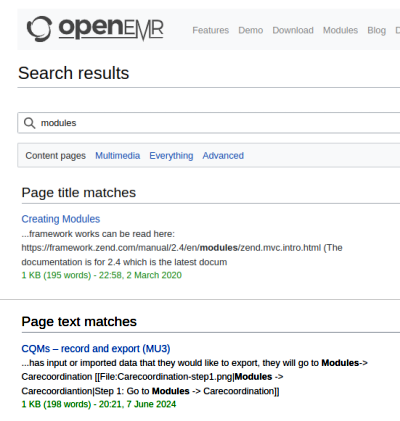Hi Folks-
Countless questions are asked here in the forum that can be answered by looking in the OpenEMR wiki, but nobody seems to know about its existence. Of course not ALL questions can be answered there but I came up with a brief tour of the OpenEMR wiki hoping it would improve peoples awareness of available resources. I’ve been working with a leading OpenEMR vendor giving user support for appx 10 years so I think I have a grip on the subject.
The OpenEMR wiki does look pretty disorganized, and it’s totally understandable that the disorganization can put people off using it. So here is my take on how to navigate the user- information part of it, hoping that will make it a little more popular.
The top level wiki page has pages on all the aspects of the entire OpenEMR project:
https://www.open-emr.org/wiki/index.php/OpenEMR_Wiki_Home_Page
Scroll down or click the link to section 2.10 User Manuals
https://www.open-emr.org/wiki/index.php/OpenEMR_Wiki_Home_Page#User_Manuals
Click the OpenEMR version you’re using, to get to the page with that version’s User Guide.
The User Guide page is duplicated for each new version of the OpenEMR, so it contains all the links to the materials published for earlier versions. It also has new links to documentation of features added in the new release.
NOTE: A skill I’m calling ‘transposing interfaces’ is where a user can look at documentation of a feature showing an older version’s interface. They identify the controls used in the old version, then find the same controls in the new version, and so can use the feature in the new version. This skill makes most of the older documentation accessible to users of the new versions, especially when the feature itself has not changed, just the interface.
The page’s Table of Contents is at the top of each User Guide page and gives links straight to the different sections.
‘Users Guide’ is the written documentation of the User workflows. No, I do not know why the sub-section ‘Wiki Format’ exists because all written docs are in wiki format. But remember, this wiki has been added to over 15+ years by lots of different contributors. You will see inconsistencies!
- This is where the specific docs are listed by the version that is pictured in the documentation.
Often a small note will say what other/earlier versions the feature exists in. - This is where ‘transposing interfaces’ comes in handy. For example, the ‘Adding a new patient’ workflow is the same in v7.0.2 as in 4.2, just the screen is arranged differently. Making an ‘External ID’ mask takes the same steps in v7 as v4, just with some different pictures.
‘Supplementary Topics’ and ‘Configuration Topics’ sections are collections of links to documentation of the more systems- oriented features of OpenEMR. Again, you will see inconsistencies.
‘Modules’ should be documentation of particular OpenEMR modules, which is one of the methods available to incorporate features into the EMR. Although some of the links are not where they should be…
‘Video Tutorials’ are just that. At one time a couple vendors and community members made some videos of certain features, but then quit. Most of the videos are for v5, but the rest are v4.x. Transposing interfaces makes the videos useful as alternative presentations of the same workflows which are shown in written format in the top part of the page.
AND FINALLY - a good way to find something in the wiki is to SEARCH for it!
At the bottom of every wiki page is a search tool:

Enter your term (the simpler it is the more results you get).
The returns come in 2 sections:
- ‘Page title matches’ where the term is found in the page title
- ‘Page text matches’ where the term is found anywhere in the page.

Now, go out there and consume that OpenEMR wiki!
Best- HT

